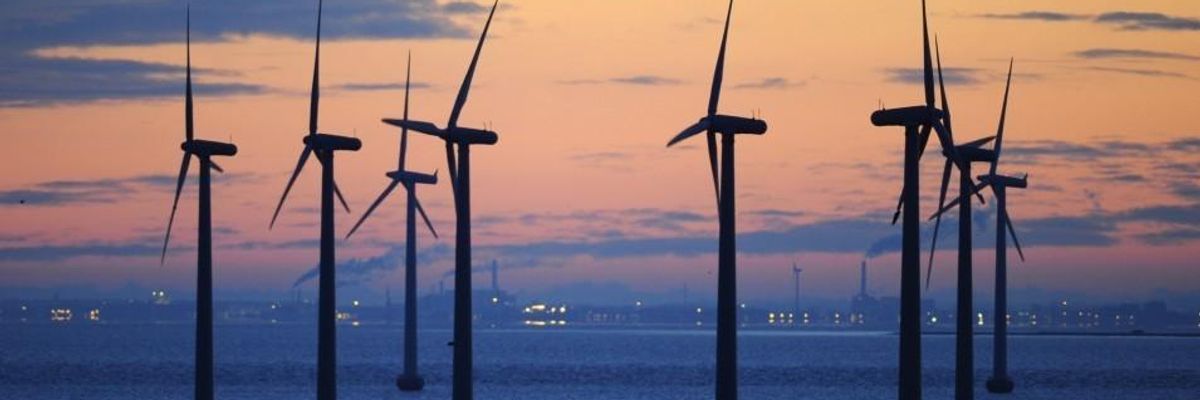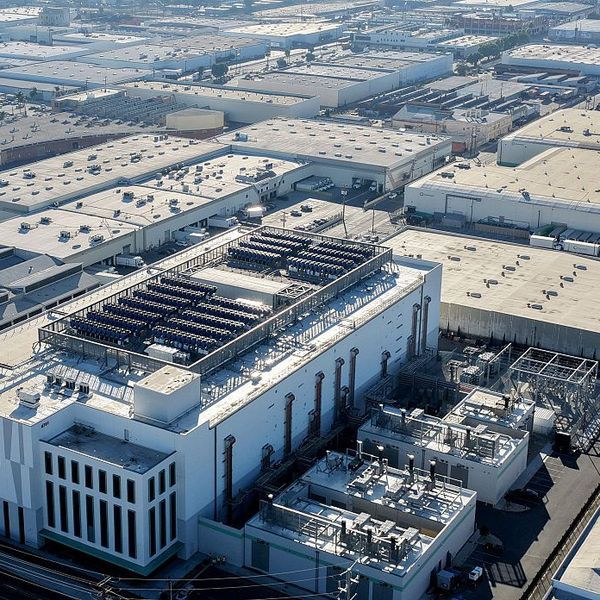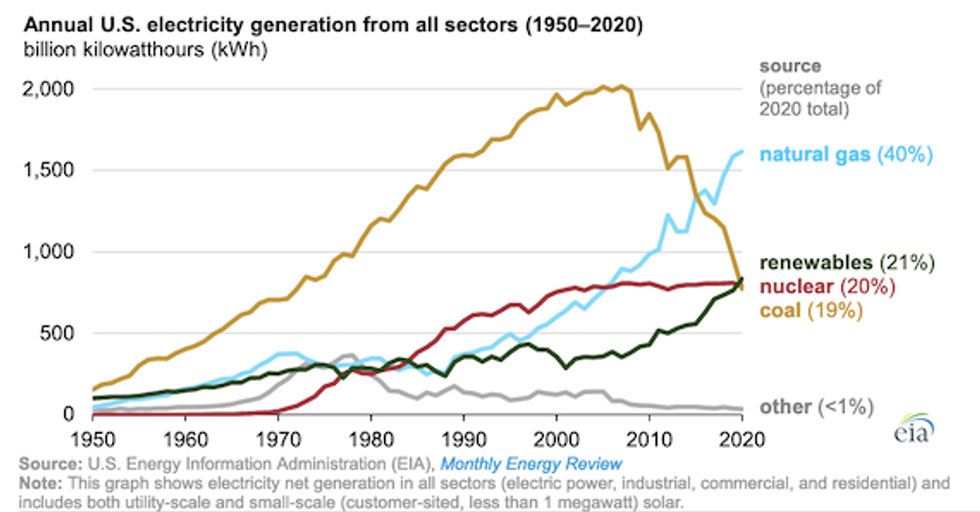
"This is the first time on record that renewables were the second-largest generator of electricity in the U.S.," Cole writes. (Photo: Axel Schmidt/AFP/Getty Images)
For First Time on Record, US Renewables Generated More Electricity Than Either Coal or Nuclear in 2020
"About half of U.S. clean energy now comes from solar and wind, and the other half from hydroelectric power."
The Energy Information Administration, the primary authority in the federal government on energy numbers, concludes that renewables, primarily hydro, wind and solar, rose to become 21% of electricity generation in the U.S. in 2020.
This is the first time on record that renewables were the second-largest generator of electricity in the U.S.
Renewables overall increased 9% between 2019 and 2020. About half of U.S. clean energy now comes from solar and wind, and the other half from hydroelectric power.
Wind generation increased by 14%.
Solar rocketed up even more, with utility-scale solar projects of 1 megawatt or more growing by 26%.
Small-scale solar such as rooftop installations like the one we have increased by 19%.
The Clean Power Association says that America put in 26 gigawatts of renewables electricity plants in 2020 -- 80% more than in 2019 -- bringing total US renewables capacity to 170 gigawatts.
In the US, some 78% of all new electricity generation was from wind and solar, which are clearly the future of the American grid.
American renewables beat out coal, now only 19%, and nuclear, at 20%. Coal is dirty and expensive, and coal power plants have been replaced in droves by wind farms and by natural gas. It was the largest generator of electricity in the US until 2016, and has gone into a tailspin because renewables and natural gas are much cheaper.
Natural gas, which is only half as carbon intensive as coal, is now the leading generator of electricity in the US, at some 40%.
Coal electricity generation fell 20% from 2019 to 2020.
Between renewables and nuclear, 41% of American electricity generation is now low-carbon or no-carbon.
While the increase clean gigawattage is impressive in American terms, China added 136 gigawatts of new renewables capacity in 2020, dwarfing the U.S. effort. This massive lead that China has in wind and solar translates into advantages in manufacturing, distribution and sales of equipment like solar panels. The U.S., for all that it is finally making some strides, is going way too slow if it wants to be a leader in these industries and if it wants to do its part to keep global heating below an extra 3.6 degrees F.
An Urgent Message From Our Co-Founder
Dear Common Dreams reader, The U.S. is on a fast track to authoritarianism like nothing I've ever seen. Meanwhile, corporate news outlets are utterly capitulating to Trump, twisting their coverage to avoid drawing his ire while lining up to stuff cash in his pockets. That's why I believe that Common Dreams is doing the best and most consequential reporting that we've ever done. Our small but mighty team is a progressive reporting powerhouse, covering the news every day that the corporate media never will. Our mission has always been simple: To inform. To inspire. And to ignite change for the common good. Now here's the key piece that I want all our readers to understand: None of this would be possible without your financial support. That's not just some fundraising cliche. It's the absolute and literal truth. We don't accept corporate advertising and never will. We don't have a paywall because we don't think people should be blocked from critical news based on their ability to pay. Everything we do is funded by the donations of readers like you. Will you donate now to help power the nonprofit, independent reporting of Common Dreams? Thank you for being a vital member of our community. Together, we can keep independent journalism alive when it’s needed most. - Craig Brown, Co-founder |
The Energy Information Administration, the primary authority in the federal government on energy numbers, concludes that renewables, primarily hydro, wind and solar, rose to become 21% of electricity generation in the U.S. in 2020.
This is the first time on record that renewables were the second-largest generator of electricity in the U.S.
Renewables overall increased 9% between 2019 and 2020. About half of U.S. clean energy now comes from solar and wind, and the other half from hydroelectric power.
Wind generation increased by 14%.
Solar rocketed up even more, with utility-scale solar projects of 1 megawatt or more growing by 26%.
Small-scale solar such as rooftop installations like the one we have increased by 19%.
The Clean Power Association says that America put in 26 gigawatts of renewables electricity plants in 2020 -- 80% more than in 2019 -- bringing total US renewables capacity to 170 gigawatts.
In the US, some 78% of all new electricity generation was from wind and solar, which are clearly the future of the American grid.
American renewables beat out coal, now only 19%, and nuclear, at 20%. Coal is dirty and expensive, and coal power plants have been replaced in droves by wind farms and by natural gas. It was the largest generator of electricity in the US until 2016, and has gone into a tailspin because renewables and natural gas are much cheaper.
Natural gas, which is only half as carbon intensive as coal, is now the leading generator of electricity in the US, at some 40%.
Coal electricity generation fell 20% from 2019 to 2020.
Between renewables and nuclear, 41% of American electricity generation is now low-carbon or no-carbon.
While the increase clean gigawattage is impressive in American terms, China added 136 gigawatts of new renewables capacity in 2020, dwarfing the U.S. effort. This massive lead that China has in wind and solar translates into advantages in manufacturing, distribution and sales of equipment like solar panels. The U.S., for all that it is finally making some strides, is going way too slow if it wants to be a leader in these industries and if it wants to do its part to keep global heating below an extra 3.6 degrees F.
The Energy Information Administration, the primary authority in the federal government on energy numbers, concludes that renewables, primarily hydro, wind and solar, rose to become 21% of electricity generation in the U.S. in 2020.
This is the first time on record that renewables were the second-largest generator of electricity in the U.S.
Renewables overall increased 9% between 2019 and 2020. About half of U.S. clean energy now comes from solar and wind, and the other half from hydroelectric power.
Wind generation increased by 14%.
Solar rocketed up even more, with utility-scale solar projects of 1 megawatt or more growing by 26%.
Small-scale solar such as rooftop installations like the one we have increased by 19%.
The Clean Power Association says that America put in 26 gigawatts of renewables electricity plants in 2020 -- 80% more than in 2019 -- bringing total US renewables capacity to 170 gigawatts.
In the US, some 78% of all new electricity generation was from wind and solar, which are clearly the future of the American grid.
American renewables beat out coal, now only 19%, and nuclear, at 20%. Coal is dirty and expensive, and coal power plants have been replaced in droves by wind farms and by natural gas. It was the largest generator of electricity in the US until 2016, and has gone into a tailspin because renewables and natural gas are much cheaper.
Natural gas, which is only half as carbon intensive as coal, is now the leading generator of electricity in the US, at some 40%.
Coal electricity generation fell 20% from 2019 to 2020.
Between renewables and nuclear, 41% of American electricity generation is now low-carbon or no-carbon.
While the increase clean gigawattage is impressive in American terms, China added 136 gigawatts of new renewables capacity in 2020, dwarfing the U.S. effort. This massive lead that China has in wind and solar translates into advantages in manufacturing, distribution and sales of equipment like solar panels. The U.S., for all that it is finally making some strides, is going way too slow if it wants to be a leader in these industries and if it wants to do its part to keep global heating below an extra 3.6 degrees F.


